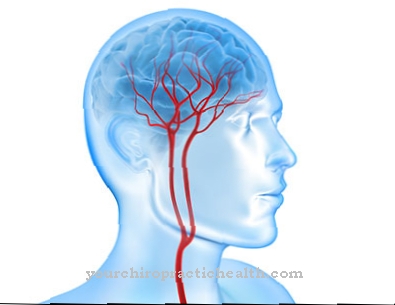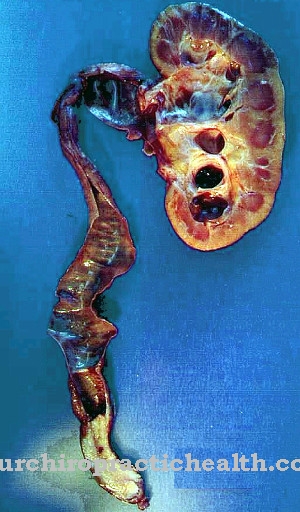Hepatitis A occurs relatively often because this inflammation of the liver affects everyone and can affect anyone. Travelers are particularly at risk. You can get vaccinated against this contagious viral disease and you can try to avoid it through hygiene measures. Hepatitis A manifests itself as jaundice and inflammation of the liver. She is treated in the hospital on infection wards. With the right treatment, hepatitis A usually heals without any problems.
What is hepatitis A?

© Evgeniy - stock.adobe.com
Hepatitis A inflammation of the liver is a global and widespread infectious disease. Every year millions of people worldwide develop this infectious viral hepatitis.
There are different ways to get infected with hepatitis A. Usually, hepatitis A is curable and does not cause serious damage if treated promptly and consistently.
However, infection with hepatitis A can also be avoided, namely through appropriate vaccination protection, which is only paid for by health insurance companies in certain cases.
causes
Like all viral hepatitis diseases, hepatitis A is triggered by a virus from the Picornaviridae virus strain. In contrast to the equally widespread viral diseases hepatitis B and hepatitis C, it is much easier to get infected with hepatitis A. Contaminated mussels, smear infections, but also sexual contact are the main sources of infection in this type of jaundice.
The infection can take place, for example, through the consumption of food, the use of contaminated water, as well as directly from person to person. Bad hygienic conditions play a major role in the transmission of the virus. Children and the elderly as well as people with weakened immune systems are particularly at risk.
In many cases, however, the exact transmission routes can no longer be traced at all. Hepatitis A is more common in the southern hemisphere, with pandemics happening in some regions of Asia and Africa every year. That means that in whole regions people get sick in rows.
But people in Central, Southern and Eastern Europe also get hepatitis A again and again. This infectious disease is also found in the Scandinavian countries, although it is noticeably rare there.
Symptoms, ailments & signs
Hepatitis A often runs without symptoms, especially in children. In adults, symptoms can occur which are initially noticeable in the form of unspecific complaints. These include a slight rise in temperature, nausea, vomiting, loss of appetite, poor performance and sometimes slight pressure pain in the right upper abdomen. Symptoms of jaundice may appear after about two weeks.
This leads to yellowing of the skin and eyes. The stool will discolour and turn whitish to clay-colored. At the same time, the urine turns dark due to the increased excretion of bilirubin. The disease usually heals on its own after a few weeks. A chronic course has not yet been observed. In the majority of cases, the symptoms remain very mild.
Asymptomatic courses occur not only in children, but also less often in adults. Jaundice does not occur in two thirds of patients. This especially affects children. The likelihood of jaundice grows with the age of the patient. In very rare cases, however, severe disease courses are also possible.
This is especially the case with previous liver damage or in severely immunocompromised people. With a brilliant course of the disease, even deaths are possible. The extremely rare course of the disease also includes the potentially fatal agranulocytosis, which is characterized by the acute breakdown of the stem cells in the bone marrow.
course
People infected with the hepatitis A virus will usually fall ill after ten days to eight weeks. The affected patients show symptoms such as vomiting, abdominal pain and fever. Usually they also develop jaundice, known as jaundice.
The eyeballs are discolored yellow, the stool is very light and the urine of the patient is very dark. People infected with hepatitis A are treated in the hospital in the infection ward because they are contagious for up to two weeks in the acute stage.
Complications
Hepatitis A can be harmless. The disease heals completely spontaneously and the person concerned receives an immunity to the virus, so that he is no longer affected by hepatitis A. A chronic course of hepatitis A has not yet been observed. In the rarest, but also most serious, cases, liver failure can occur due to hepatitis A.
As a result, the liver is no longer able to carry out the important biochemical processes, so that the body then lacks many proteins and the detoxification function fails. As a result, edema can occur or the coagulation no longer works properly. The cell toxin ammonia can also pass into the brain, for example, leading to hepatic encephalopathy.
Hepatitis A is also contagious. Travelers who contracted the virus abroad can transmit the virus fecal-orally in their home country, leading to a local outbreak. Normally in 90 percent of cases the disease heals quickly, only in ten percent the disease can last up to twelve months. The number of infections and deaths from hepatitis A increases with age.
When should you go to the doctor?
Hepatitis A is a serious illness which, in the worst case scenario, can lead to death. For this reason, a doctor must be consulted immediately at the first signs of hepatitis A in order to avoid further complications. The disease is characterized by jaundice and severe fatigue. The tiredness and weakness cannot be counteracted with the help of sleep. Severe headaches and loss of appetite also indicate hepatitis A and must be investigated.
Pain in the abdomen is just as common and this is usually accompanied by a fever. The urine can turn dark in hepatitis A. The doctor should be consulted if jaundice occurs. Immediate treatment is necessary, especially after staying in affected areas. Diagnosis and treatment can be done in a hospital or by a general practitioner. Since the disease is contagious, those affected must always be admitted to an infection ward.
Doctors & therapists in your area
Treatment & Therapy
As with any liver disease, the patient with hepatitis A must keep absolute bed rest or at least take physical rest. The doctor will make the final diagnosis based on blood tests that detect the virus. Depending on the level of the viral load, there is a more or less pronounced clinical picture. In addition to other liver values, the doctor finds elevated bilirubin values in the blood.
The sedimentation rate is also increased, which indicates inflammation of the liver cells. The patient is given strengthening infusions, depending on their general condition. After any food abstention, the slow build-up with liver sparing follows.
Hepatitis A is difficult to treat only in rare cases, for example if there is another infection with hepatitis B or C. In this case, additional and long-term treatment is required, possibly with a combination therapy of interferon and ribavirin.
Outlook & forecast
Hepatitis A has a good prognosis. The disease heals completely when the patient receives medical care. A chronic course of the disease can be excluded in hepatitis A. The peculiarity of the disease is a lifelong immunity to the pathogen. A recurrence or relapse of the disease are therefore excluded. The healing process usually takes several months. The patient should maintain strict bed rest for a good prognosis.
Delays or complications occur when consuming alcohol or taking harmful medication. These can lead to the destruction of the liver tissue and trigger functional disorders of the organ. In rare cases, hepatitis A disease may require a liver transplant.
The death rate is low, one to two percent of patients. The likelihood of a fatal course of the disease increases with age. For people over 50 years of age it is three percent. Without medical treatment and adherence to the restraint, the risk of permanent liver damage increases. The patient's condition worsens and a fatal outcome becomes more likely.
Alternative healing methods are not recommended for hepatitis A. The best way to fight the virus is to give medicine and keep calm.
prevention
Hepatitis A is preferably avoided with preventive vaccinations. Usually a combination drug against hepatitis A and B is administered. This vaccination must be given several times as instructed by the attending physician or vaccination center. When traveling to African, South American and Asian countries, it is recommended in any case, if nothing speaks against the doctor, to have these vaccinations carried out.
People suffering from chronic hepatitis C should also get vaccinated against hepatitis A and B as a preventative measure to avoid complications.
If there is no vaccination protection, one should at least exercise the necessary caution. Above all, this includes very careful hygiene and responsible handling of the food offered in exotic holiday destinations. Raw food and mussels should not be eaten at all, fruits should only be peeled. Drinks are only consumed from unopened bottles, ice cream and desserts are to be avoided. Vaccination and hygiene therefore largely protect against hepatitis A.
Aftercare
There is no specific treatment for hepatitis A. Recovery from symptoms after infection can be slow, lasting several weeks or even a few months. The focus here is on avoiding unnecessary medication. Acetaminophen or paracetamol and any other anti-vomiting medication should not be given.
Hospitalization is unnecessary if there is no acute liver failure. Therapy is aimed at maintaining well-being and adequate nutrient levels, including replacing fluids lost through vomiting and diarrhea. Improved hygiene, food safety, and vaccination are the most effective means of fighting hepatitis A.
The spread of hepatitis A can be curbed by a proper supply of clean or treated drinking water, legal disposal of wastewater in cities and personal hygiene measures such as regular hand washing with clean water.
Several injectable inactivated hepatitis A vaccines are available internationally. We work quite similarly when it comes to how well they protect each individual from the virus and its accompanying symptoms. No vaccine is approved for children under one year of age. The vaccine is given by injection. A starting dose provides protection for one year from two to four weeks after vaccination; the second booster dose, given six to twelve months later, provides protection for over 20 years.
You can do that yourself
If an infection with hepatitis A has been found, rest and rest. Those affected should eat a healthy and balanced diet and avoid alcohol. Anyone who regularly takes drugs that stress the liver should change the medication in consultation with the doctor. By avoiding very fatty foods and luxury foods, the liver can also be relieved.
Measures from naturopathy and homeopathy can be used to support this: Milk thistle to improve liver values, Shiatsu applications to promote relaxation or autologous ozone treatment to eliminate toxins. Friends and relatives of sick people should also get vaccinated against hepatitis A immediately.
Comprehensive hygiene measures such as regular hand washing, cleanliness when preparing food as well as separate towels and, if possible, separate toilets are also important. If the sick person needs assistance with personal hygiene, disposable gloves and disinfectant soap should be used.
In any case, the patient's laundry should be washed hot and stored separately. The doctor responsible can give further tips and assistance on how people in the vicinity of the person affected can protect themselves from being infected with hepatitis A.



.jpg)

.jpg)
.jpg)




















